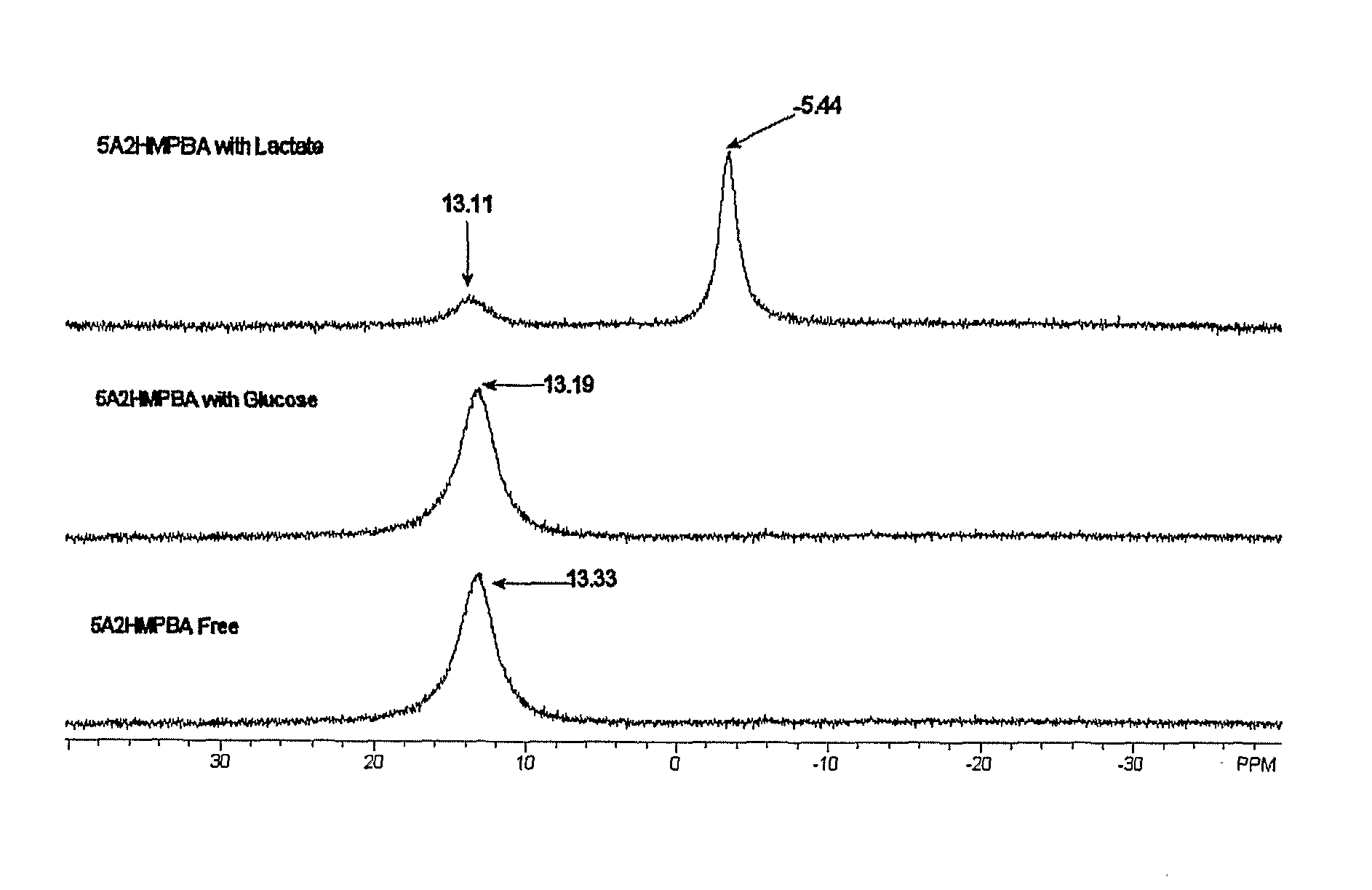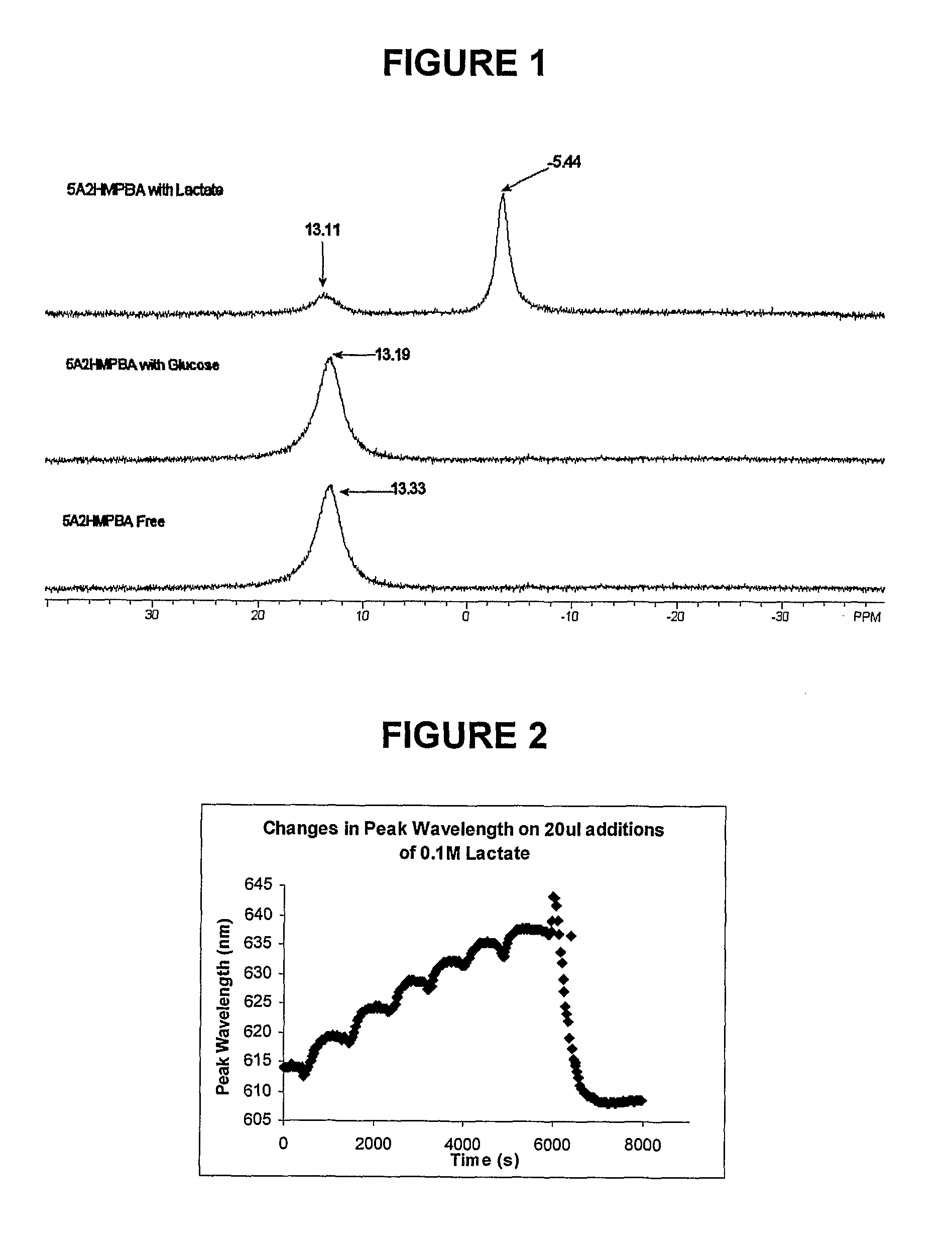Sensor molecules incorporating a boronic acid sensor group
a sensor group and sensor technology, applied in the field of chemical analysis, can solve the problem of not providing a teaching of its possible us
- Summary
- Abstract
- Description
- Claims
- Application Information
AI Technical Summary
Problems solved by technology
Method used
Image
Examples
example 1
Synthesis of BOBA
N-(1-Hydroxy-1,3-dihydro-benzo[c][1,2]oxaborol-6-yl)-acrylamide
[0263]
[0264]A solution of 5A2HMPBA (0.5 g, 0.0027 mol) in 3 mL water was cooled in an ice bath. A solution of sodium hydroxide (0.2 g in 2 mL, 0.0054 mol) was added. The resulting pH was ˜8. Acryloyl chloride (0.5 mL, 0.0054 mol) was added dropwise (a white precipitate formed immediately) over a period of 5 minutes. The mixture was then left to stir while monitoring the pH (ideally the pH should be maintained between pH 7 and 9). No change in pH was observed. The mixture was allowed to stand overnight while warming to room temperature. The grey precipitate was filtered off and washed with cold water. The product was allowed to dry under high vacuum line over P2O5.
example 2
Synthesis of a 10% BOBA Polyacrylamide Polymer
[0265]A 10 mol % BOBA polyacrylamide polymer was prepared from the following monomers:
[0266]
Monomermol. wt.mgmmolmole %acrylamide71.0892.591.303~88.19N,N′-methylenebis(acrylamide)154.173.930.0255~1.73BOBA203.0030.280.149~10.08
[0267]The monomers were dissolved in 250 μL of solution of 2% (w / v) 2-dimethoxy-2-phenyl acetophenone (DMPA) in dimethylsulfoxide (DMSO). A 100 μL aliquot of this mixture was pipetted onto the polyester surface of an aluminised polyester sheet set on a glass plate. A glass microscope slide, which had been treated with 3-(trimethoxysilyl)-propyl methacrylate, was then placed, silane-treated side down, onto the monomer mixture. The films were polymerised by UV initiated free radical reaction at 20° C. for approximately 1 hour (˜350 nm; UV exposure unit, Model No. 555-279, RS components, UK). The polymerised films were pealed off the aluminised polyester sheet while immersed in deionised water. The slides were left to ...
example 3
Preparation of a (Silverless) Holographic Element Employing BOBA Polymer
[0268]A silverless holographic element was prepared by forming a second polymer (P2) “within” the 10 mol % BOBA polyacrylamide polymer. The following liquid mixture (EXL 2 solution) was prepared from the following materials:
[0269]
2-dimethoxy-2-phenyl acetophenone (DMPA)5mgIrgacure 29595mg1,4-bis(acryloyl)piperazine (BAP)0.4gdiethylene glycol (DIGOL)1000μLdeionised water4mltriethylamine (TEA)40μL2% ascorbic acid100μL(Irgacure 2959 is 1-[4-(2-hydroxyethoxy)-phenyl]-2-hydroxy-2-methyl-1-propane-1-one, a highly efficient non-yellowing radical photoinitiator for UV curing systems.)
[0270]The 10 mol % BOBA polyacrylamide polymer films were placed “face-down” onto 400 μL of the EXL 2 solution and allowed to stand for 30 minutes, absorbing the liquid. Excess solution was wiped off with a rubber wiper blade and the slide was allowed to dry, polymer “face-up”, under a fan for 3 hours.
[0271]Holograms were then formed within...
PUM
| Property | Measurement | Unit |
|---|---|---|
| refractive index | aaaaa | aaaaa |
| pKa | aaaaa | aaaaa |
| molar ratio | aaaaa | aaaaa |
Abstract
Description
Claims
Application Information
 Login to View More
Login to View More - R&D
- Intellectual Property
- Life Sciences
- Materials
- Tech Scout
- Unparalleled Data Quality
- Higher Quality Content
- 60% Fewer Hallucinations
Browse by: Latest US Patents, China's latest patents, Technical Efficacy Thesaurus, Application Domain, Technology Topic, Popular Technical Reports.
© 2025 PatSnap. All rights reserved.Legal|Privacy policy|Modern Slavery Act Transparency Statement|Sitemap|About US| Contact US: help@patsnap.com



